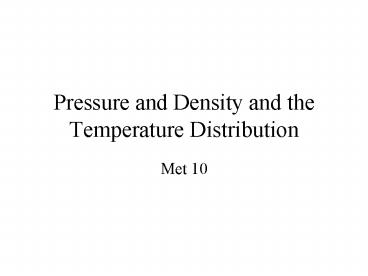Pressure and Density and the Temperature Distribution PowerPoint PPT Presentation
1 / 19
Title: Pressure and Density and the Temperature Distribution
1
Pressure and Density and the Temperature
Distribution
- Met 10
2
Introduction
- Temperature, density and pressure are some of the
most important variables in meteorology - Knowing all of these quantities at all times and
places would make understanding and forecasting
weather events much easier - Linked together via the gas law
- pV nRT
- Pressure differences cause winds, which are
caused by the uneven heating at the surface!!!! - So, the uneven heating of the surface causes the
weather!
3
Pressure
- Gravity causes the atmosphere to exert a downward
force on the surface. - Simply put, its the weight of air above you.
- Pressure falls off rapidly w/ height, so it
doesnt take long until air is very thin. - E.g. Whats the pressure in Lake Tahoe and Death
Valley?? Look at a places elevation. - Pressure does not change as much in the
horizontal - However, these changes are the high and
low-pressure systems that may bring certain types
of weather events - So these are most important to meteorologists
- Its the pressure differences we care about,
since these are what cause winds!
4
Pressure is commonly measured using a Barometer.
5
Pressure extremes
6
Density
- of air molecules per volume
- Physically, it is mass per unit volume
- E.g. population density
- Density falls off rapidly w/ height, so it
doesnt take long until air is very thin.
7
Vertical structure of pressure and density
8
Pressure changes with height
9
Temperature
- Definition Averagre speed of molecules
- Faster speed is synonymous with warmer
temperatures, and vice versa. - Can also be thought of as energy.
- Hotter objects have more energy associated.
- Colder less energy
- E.g. Warmer areas are areas of more energy.
- Changes in temperature/energy can lead to changes
in pressure and volume, via the gas law. pVnRT
10
Temperature Scales
- Fahrenheit created 18th century physicist
- freezing point of water 32
- Boiling point 212
- 0 is the lowest temperature he could reach using
Salt, Ice and Water - F 9/5C 32
- Celsius Used worldwide
- Made 0 the freezing point
- 100 boiling point
- C 5/9(F - 32)
- Kelvin Absolute temperature scale
- At 0 K, all molecular movement stops!
- K C 273.15
11
Thermometers
- Thermometers work because substances (like
mercury) expand and contract with changes in
temperature. - Warmer temperature, fluid expands
- Colder temperature, fluid contricts
- Mercury not used much anymore
12
- Three temperature scales
- Kelvin
- Celsius
- Fahrenheit
- What does temperature mean physically?
- What does 0 K mean?
13
Vertical temperature structure
- 4 levels
- troposphere, stratosphere, mesosphere,
thermosphere - we look mostly at the troposphere, where weather
happens - 80 of all mass, nearly all vapor,
clouds/precipitation - a little at the stratosphere, where ozone is at
max and explains warming in stratosphere - In stratosphere Ozone layer O3 absorbs solar
energy and waves. - lapse rate How temperature changes with height
- Not constant in the atmosphere
- Typically, it cools 3 - 5 degrees per 1000 ft
- Depends on how much moisture is in the air
14
(No Transcript)
15
(No Transcript)
16
Climatological temperature variability
Latitudinal
- A places climate depends on its latitude
- Whats latitude?
- Poles, mid-latitudes, tropics?
- Polar/high latitudes 60-90º
- Mid-latitudes 30-60º
- Tropical/low latitudes 0-30º
- The temperature differences (gradient) between
poles and equator are twice as large in their
winter season. - This causes mid-latitude weather systems like
cold/warm fronts and high and low-pressure areas
17
(No Transcript)
18
(No Transcript)
19
Precipitation Types
- Rain
- Snow
- Sleet
- Hail
- Feezing Rain

